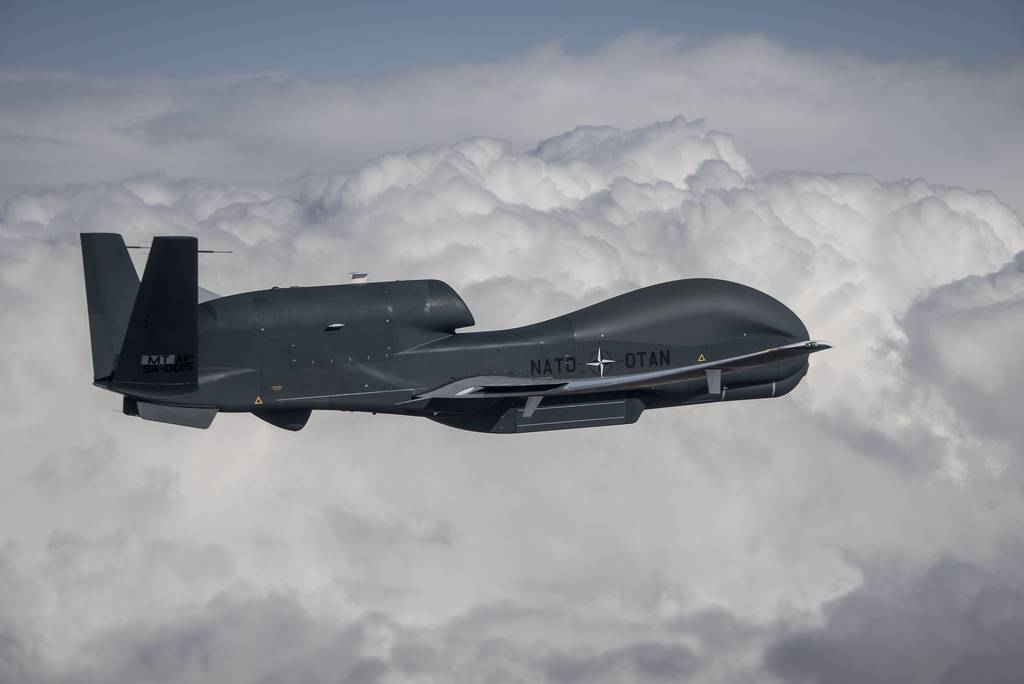ROME — Global Hawk drones flown by NATO from their Italian base will soon be racking up 100 hours of flying time per week between them, and boasting a new maritime target tracking capability, alliance officials have said.
The ambitious targets for the five drones, now based at Sigonella air base in Sicily, come as the NATO Allied Ground Surveillance program aims for full operating capability status in 2024.
Some 350 staff with the AGS program are already based at Sigonella, a number which will rise to 600 by the time FOC status is obtained. Those staff members will handle data from the drones’ Synthetic Aperture Radar/Ground Moving Target Indicator capability, said AGS chief Brig. Gen. Houston Cantwell.
“NATO AGS receives an unbelievable amount of data during each flight. We will continue to onboard greater numbers of intelligence analysts to handle the increasing amount of SAR images and GMTI data,” the U.S. official told Defense News.
After years of delays, AGS reached initial operating capability in February 2021 after the last of its fleet of five drones arrived in November 2020.
Based on the American RQ-4 Global Hawk airframe, the NATO drones are referred to as RQ-4D Phoenix aircraft.
Owned by a collective of 15 NATO members, the platforms now operate over NATO countries, flying to 60,000 feet with a range of 8,700 nautical miles.
Access to the airspace of NATO partners and other non-NATO nations must be regulated through bilateral or multilateral agreements, officials said.
No sooner had it arrived, one of the five has been flown to California to be equipped with the so-called GMTI-over-Sea capability, allowing it to track moving maritime targets as well as moving land targets.
“NATO AGS looks to support both land and maritime operations,” Cantwell said. “This radar enhancement will improve our ability to contribute to the maritime surface picture in defense of the alliance.”
The data link known as Link 16 is also due to be added to the drones as full operating capability approaches. On the ground, Cantwell said the data-processing operation was now mature enough to handle input from other platforms, not just the five Phoenix drones.
“We already receive raw intelligence data from other platforms and perform analysis in support of NATO commanders and decision-makers,” he said.
Flying hours are also on the rise. Currently, with its initial operating status, just one of the drones, on a rotating basis, is making one 12-hour flight per week. A flight of that length will give a drone 1-2 hours on station in the Baltics.
When full operating capability is reached in 2024, individual flights will see an extension to 30 hours, with the fleet reaching a total of about 100 hours of flight time weekly, according to projections.
Phoenix flights are undertaken at high altitude, above commercial flight paths in regulated corridors.
To reach the right altitude, the drones climb after takeoff from Sigonella out over the Mediterranean Sea. Impact on regular aircraft leaving nearby Catania airport is avoided, as the Italian air traffic control system coordinates the AGS aircraft, just as it also handles U.S. Air Force Global Hawks, which also operate from Sigonella.
There are also designated emergency airfields available should an AGS drone need to make an emergency landing while over a NATO country.
Recent press reports suggested that U.S. Global Hawks flying out of Sigonella were the target of jamming by Russia as they carry out surveillance around the Black Sea, the Crimean Peninsula and eastern Ukraine.
Cantwell declined to say if AGS drones had been targeted, but did note: “Any aircraft operating in the vicinity of adversarial emitters can experience the effects of jamming. NATO AGS takes all threats seriously and monitors the situation closely to best understand any and all risks associated with operating around the NATO alliance.”
Tom Kington is the Italy correspondent for Defense News.








